The Fulda Gap
By Bill Wilson
|
~DEDICATION~
To the men of the 11th and 14th Armored Cavalry Regiments who gave their lives while serving in Cold War Germany R. I. P. |
|
Not for ourselves alone are we born
- Cicero |
Lariat Advance. This terse and odd phrase, typically delivered via telephone in the early hours of the morning, served over years of the Cold War as an unmistakable notice to U.S. soldiers in Germany that a unit alert had been declared and that henceforth every second counted until such time as the unit’s response to alert had been assessed, and hopefully found satisfactory. Soldiers who lived outside the unit’s base reported in, vehicles and personal equipment were made ready, and finally, the unit deployed to its designated alert location in the countryside.
For those NATO soldiers whose units were deployed in the vicinity of the Iron Curtain, these alerts were laden with additional tension because the nearby presence of the Soviet forces was palpable. As one responded to the alert and approached the Kaserne, thoughts inevitably assessed how “real” the alert might be. For the U.S. Army in Germany in general, and its V (Fifth) Corps in particular, the geographical focus of this concern was known as the Fulda Gap.
Although VII Corps in Bavaria had another terrain corridor, the Hof Gap, as its focus, when it came to anticipated operations in Europe, the U.S. Army firmly expected the first battle of the next war to be a major clash of armored forces in the Fulda Gap. “The Gap”, like the Demilitarized Zone between the two Koreas, came to represent an assignment of special responsibility for those U.S. soldiers destined for promotion to high rank. The standards for performance of duty in such assignments were uncompromising, and those who met the requirements were considered to have performed well in the closest thing to war during times of peace.
Unlike the Demilitarized Zone, the defense of the Fulda Gap came to be associated with a particular type of military formation, that of the armored cavalry. As the defense of this terrain feature came to be seen as a key battle of a future war, so soared the standards and performance of the cavalry units assigned to defend it. Although both cavalry regiments assigned to the defense of the Gap over 41 years had seen service in “hot” wars, their Cold War service impacted generations of American soldiers who served in Germany and lent a sense that the shared experience in Fulda had been something much more intense than that typically associated with garrison duty in peacetime.
This document will discuss what the Fulda Gap was, its importance in the context of the Cold War, and the units responsible for its defense. As the U.S. Army confronts various enemies in distant corners of the world, its institutional memory of its Cold War service has perforce faded. In view of this, it is perhaps time for those of us who served during the Cold War to put our memories and impressions of these times to paper – not for any purpose of self-glorification – but rather, to give due honor to those comrades who lost their lives in the supposed peace of the Cold War.
|
Colder than Billy Hell
- Author’s recollection of winter in the Rhön Mountains. |
What, precisely, was meant by the term “Fulda Gap” ? A gap in the meaning of terrain is in some instances easily recognizable, such as in the areas of the Belfort or Wissembourg Gaps. The general meaning refers to a corridor of terrain that is lower in elevation than the surrounding topography and more easily passable.
In the case of the Fulda Gap, the definition was a bit more loosely applied, and referred to two east-west terrain corridors leading westward from the general area of Eisenach to Frankfurt am Main. The northern route through the Gap passes south of the Knüllgebirge and then continues around the northern edge of the Vogelsberg Mountains; the narrower southern route passes through the Fliede and Kinzig Valleys, with the Vogelsberg to the northwest and the Rhön and Spessart mountains to the southeast.
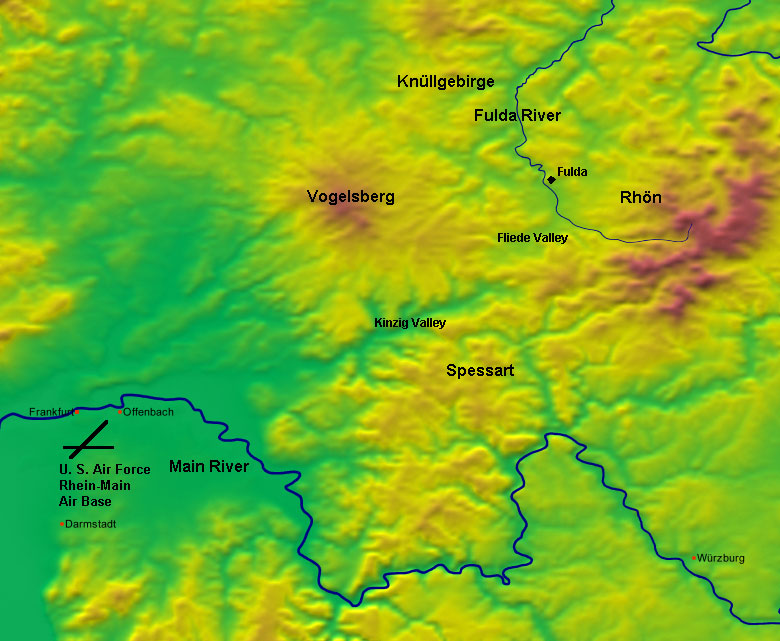
Terrain of the Fulda Gap - topography |
The terrain corridors of the Fulda Gap are neither particularly flat nor broad. They were, however, suitable for the advance of mechanized forces on a large enough scale to present a significant threat to the U.S. V Corps in the context of the Cold War. The Corps itself was headquartered in Frankfurt, the financial center of West Germany. In the immediate neighborhood of Frankfurt was West Germany’s largest airport, as well as Rhein-Main, a large air base of the U.S. Air Force suited to the employment of transport aircraft. Beyond Frankfurt, it is only some twenty kilometers to the Rhine River, the bridging of which was considered to be a primary objective of any Soviet assault into NATO’s defenses.
For an attacking force, an unattractive characteristic of the Fulda Gap is the patchy nature of forestation in the area. There are numerous forested areas large enough to conceal defenders and which overlook rolling farmland – the sort of terrain ideal for the conduct of anti-armor ambushes. But the forested areas are not large enough to provide enduring concealment from the air for a large mechanized force on the move. Elevation in the region for the most part varies between 400 and 800 meters, and the forested areas tend to be found in the hill country.
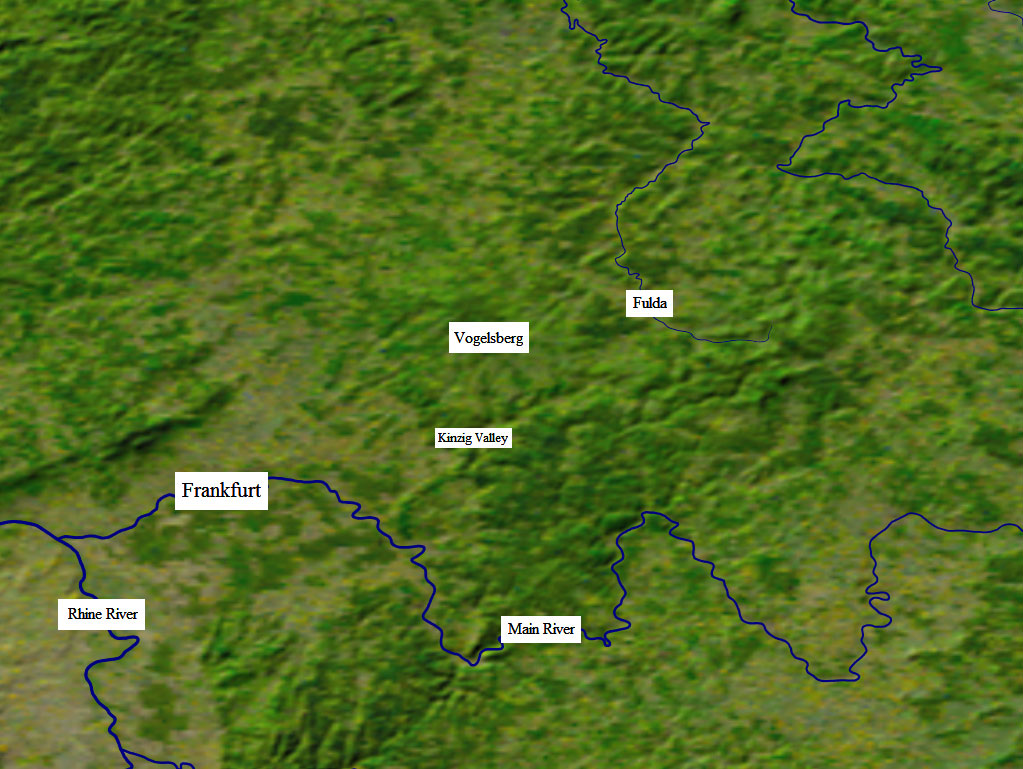
Terrain of the Fulda Gap – forestation |
A basic question about the Fulda Gap is when the term as such came into currency. This terrain corridor had been used by military forces prior to the Cold War. Napoleon retreated westward through the gap in late 1813 following the Battle of the Nations. A little over 130 years later, the U.S. XII Corps of General Patton’s Third Army pushed eastward through the gap in April 1945. The Germans have their own term for the gap, Fulda-Lücke, but this term may have been derived from U.S. usage during the Cold War.
U.S. use of the term seems to have emerged sometime between the close of the Second World War in Europe and 1946. While the U.S. Third Army’s official report of operations describes the army’s advance through the Fulda area in 1945, the term “Fulda Gap” does not appear in this work. Likewise, Lucky Forward, a book about the Third Army written by a member of Patton’s wartime staff, does not use the term in the context of operations around Fulda.
The immediate postwar era was a logical time for the term to be devised, for the occupation zones in Germany came into being in mid-1945. The presence of powerful Soviet formations in Thuringia, coupled with the emergence of the Cold War, would have prompted U.S. Army planners to consider how those Soviet formations might be employed in wartime, and thus the terrain corridors of Fulda were identified as likely avenues of advance of any Soviet attack. Lending weight to this notion, the final volume of the Seventh Army’s wartime official history, published in May 1946, includes a map titled “Terrain Study of southern Germany” – and on this map, the Fulda Gap is identified as such.
Certainly, the relative importance of the Fulda Gap as a potential Cold War battlefield has to be measured in comparison to other likely Soviet avenues of advance into West Germany. The north German plain, for example, was considered prime terrain for any Soviet thrust against the key German port of Bremerhaven and the NATO lines of communication thereupon dependent. But while a Soviet general offensive would have certainly attempted to disrupt NATO’s supply lines extending from the northern ports, another significant objective would have been the defeat of U.S. conventional forces in Europe. As the United States was the key member of NATO, an unambiguous defeat of U.S. forces in Germany would have delivered a weighty psychological blow to the other members of the alliance.
Of the U.S. Army’s forces in Germany, V Corps had been tasked with the defense of the shortest path (some 100 kilometers) from East Germany to the Rhine River. An advance by the Soviets to the Rhine River via the Fulda Gap would have essentially split the American forces in Germany into two parts. Both sides in the Cold War were well aware of the military importance of the Fulda Gap – and a defeat of U.S. forces defending there would have meant defeat for U.S. forces in Germany overall. Being responsible for the defense of the Fulda Gap meant V Corps had been assigned a mission of critical importance – in times of both peace and war. With an understanding of how very important as military terrain the Fulda Gap was, it is time to consider the forces tasked with its defense.
|
Theirs but to do and die
- Tennyson, The Charge of the Light Brigade |
Some familiarity with the U.S. and Soviet forces of the latter part of the Cold War has come about as a result of written works and commercially produced wargames. Less well known are the forces of both sides during the early part of the Cold War, even to military enthusiasts.
The military situation in Europe did not immediately transform from a worldwide struggle against Nazism to an ideological confrontation between communism and capitalism. The collapse of the Third Reich left millions of “displaced persons” within the borders of the former Reich, and the utter disappearance of an organized economy set these people, as well as the Germans themselves, into motion with the single-minded goal of surviving from one day to the next. Unsurprisingly, the situation produced much disorder, including criminality of many types. As disorder was precisely what the occupying powers of Germany did not desire, the priorities of both the western Allies and the Soviet Union in the immediate postwar period were more focused on the imposition of social and economic order than on the enduring ideological struggle that later came to be a hallmark of the Cold War.
Nevertheless, as there were four occupation zones in Germany, all four occupation powers (the U.S., the Soviet Union, Great Britain, and France) exerted significant effort to prevent smuggling of goods and unauthorized crossings by people from one zone to another. Due to the nature of the Stalinist state, the Soviets were overwhelmingly the power most concerned with assertion of control over economic and political matters in their zone of occupation, but the three western Allied powers were also intent on suppressing any lingering influence of the Nazi state in their zones of occupation, and this inevitably led to the significant involvement of these powers in the reform of West German political and economic organization and processes.
Although the initial U.S. occupation forces included three infantry divisions, their occupation role was more oriented to police and security operations than to readiness for tactical and operational warfare. By mid-1947, U.S. forces in West Germany had shrunk to a single division (1st Infantry Division) and a small host of mobile security regiments known as the U.S. Constabulary. On the other hand, the Soviet Army remained a force focused on warfare as the Soviets had marched into East Germany with entire divisions and regiments of the NKVD, the communist state secret police, and thus the Soviets had a separate force with which to impose their ham-fisted vision of order.
Those familiar with military organization at the close of the Second World War will know how the respective forces were organized in mid-1945. But organizational developments that had begun during the war matured and quickly transformed to greater or lesser degree the forces of both the United States and the Soviet Union.
On the part of the Soviets, they had been overawed by the sheer tactical and operational effectiveness of the Wehrmacht. In the four years following the end of the war in Europe, they rapidly reorganized their tank and mechanized “corps” (actually division-sized units by Western standards) into tank and mechanized divisions the organization of which owed much to that adopted by the Germans in late 1943. Similarly, the Soviets jettisoned the use of understrength rifle divisions (and their subordination to “rifle corps”), forming fewer but stronger rifle divisions that much more closely matched their authorized strength. The wartime penchant for independent tank brigades disappeared as tank and self-propelled gun regiments became organic to rifle divisions in the ensuing reorganization. The degree of motorization increased overall and the use of horses for transport fell out of use with the exception of a handful of cavalry divisions employed in the wilds of central Asia.
In the initial decades of the Cold War, the U.S. maintained a significant difference in the organization and combat power (expressed as weight of fire) of infantry and armored divisions. Before the U.S. formed mechanized infantry divisions in the 1960’s, the older style of “leg” formations held sway although they were reinforced with a tank battalion organic to the division and additional tank companies organic to each infantry regiment. U.S. armored divisions retained an organization similar to that of the Second World War but with more modern tanks. In the immediate postwar years, though, U.S. armored divisions were not part of the force structure in occupied Germany.
Both sides increased the quantity and quality of antitank and anti-aircraft weapons in their divisions, although guided missiles had not yet appeared in the national inventories. In particular, shaped-charged antitank weapons in the form of rocket launchers and recoilless rifles proliferated and replaced the unwieldy wartime antitank guns. The Soviets rapidly fielded the excellent RPG-2, a development of the German Panzerfaust. The U.S. continued to field the 60-mm Bazooka until it proved unable to cope with Soviet tanks employed in 1950 by the North Korean People’s Army. This embarrassment prompted the swift deployment of an 89-mm version of the Bazooka that was capable of defeating the armor of the T-34 tank. With recoilless rifles, the Soviets deployed several types, but none that compared to the classic U.S. “106-mm” (actually 105-mm) M40 rifle, an antitank weapon of both impressive reliability and accuracy as well as possessing an armor penetration capability that rated highly during the 1950’s – 60’s.
One armaments trend had already been established and would remain for the entire Cold War. The Soviet tanks, though less sophisticated than U.S. designs, mounted heavier cannon and had lower profiles – no mean advantage in armored warfare. The U.S. also lagged in the development of infantry weapons. The Soviets developed their excellent Kalishnikov assault rifle in the late 1940’s while the U.S. kept semi-automatic rifles in service well into the 1960’s.
Already by 1947, the two Soviet field armies facing the Fulda Gap were stationed in the areas they would occupy for the remainder of the Cold War – the 8th Guards Army in the area of Weimar and the 1st Guards Tank Army around Dresden. At this time, the U.S. had a single infantry division in Germany, and border control in the Fulda Gap was shared between the 1st and 3rd Constabulary Regiments. By late 1947, the border region east of Fulda had been made the responsibility of the 14th Constabulary Regiment.
With the imposition by the Soviets of the Berlin Blockade in June 1948, the decision was made to transform the forces on the border into tactical units, and in late 1948, the 14th Constabulary Regiment was inactivated, reorganized, and renamed the 14th Armored Cavalry Regiment. Overall U.S. strength in Germany remained low until the outbreak of the Korean War prompted significant increases in force structure. Seventh Army was activated in Stuttgart on December 1, 1950.
In mid-1951, the 4th Infantry and 2nd Armored Divisions arrived in Frankfurt and Bad Kreuznach and were subordinated to V Corps, which was activated in Frankfurt in August 1951. In the same year, the 14th Armored Cavalry moved to garrisons in Bad Hersfeld, Fulda, and Bad Kissingen. While the units subordinated to V Corps would change over the years, the pattern of American defense of the Fulda Gap had been established – a forward deployed armored cavalry regiment screening the inner German border, and two divisions deployed in depth along the axis Fulda – Frankfurt – Bad Kreuznach. With this posture, V Corps would stand in hair-trigger readiness to defend the Fulda Gap for the next 38 years.
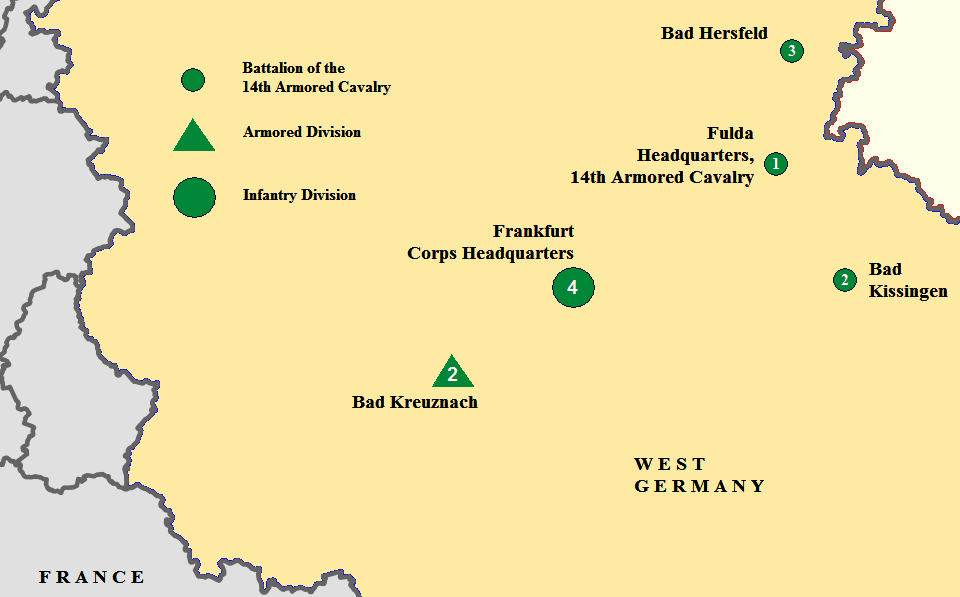
V Corps deployment in 1952 |
During the mid-1950’s the U. S. Army conducted full-unit rotations between Germany and the United States. In 1956 – 57, both divisions of V Corps returned to the USA. During this change of guard, V Corps switched the position of its divisions with the 3rd Armored Division establishing its headquarters in Frankfurt and the 8th Infantry Division doing the same at Bad Kreuznach. This change deployed the corps’ most powerful division on the same side of the Rhine as Frankfurt and closer to the Fulda Gap where it was expected to meet the armored juggernaut of any Soviet invasion.
The Soviets continued their force restructuring during the 1950’s. Regular rifle divisions were gradually dropped and the mechanized divisions became motor-rifle divisions. By 1957, the following forces were deployed in southern East Germany and believed to be likely opponents of V Corps in the event of war:
| 8th Guards Army (Weimar) | 1st Guards Tank Army (Dresden) | Military Region III* |
| 27th Guards Tank Division | 11th Guards Tank Division | 7th Tank Division |
| 21st Guards Motor-Rifle Division | 13th Tank Division | 4th Motor-Rifle Division |
| 39th Guards Motor-Rifle Division | 20th Guards Motor-Rifle Division | 11th Motor-Rifle Division |
| 57th Guards Motor-Rifle Division |
* East German forces. The 4th Motor-Rifle Division was at Erfurt and Dresden was the garrison of the 7th Tank Division. 11th Motor-Rifle division was based in Halle.
Clearly, had war broken out, V Corps would have faced stiff odds: the Warsaw Pact forces arrayed against them fielded more divisions than V Corps had maneuver brigades and regiments.
This conventional forces order of battle changed little for the rest of the Cold War. By 1965, Soviet reassignment of divisional identification numbers had stabilized:
| 8th Guards Army (Weimar) | 1st Guards Tank Army (Dresden) | |
| 79th Guards Tank Division | 9th Tank Division | |
| 27th Guards Motor-Rifle Division | 11th Guards Tank Division | |
| 39th Guards Motor-Rifle Division | 20th Guards Motor-Rifle Division | |
| 57th Guards Motor-Rifle Division |
In the U.S. forces, the withdrawal of the Army from Vietnam led to the 1972 inactivation of the 14th Armored Cavalry. In practice, the unit was reflagged as the 11th Armored Cavalry Regiment and the border surveillance and covering force mission continued as it had since 1951.
By the 1970’s, tactics had been impacted by several technical innovations. Helicopter gunships mounting automatic cannon, high-explosive rockets, and antitank guided missiles were entering service as a form of aerial artillery organic to ground combat formations. Guided missiles were also present in the ground forces of both sides. These weapons combined a formidable shaped charge warhead with reasonable accuracy at ranges bettering those of tank cannon. As far as the tank cannon went, armor-piercing projectiles had improved dramatically as had the vehicle optics and fire control systems. Ironically, the potential of these system improvements to enable truly long range engagements was hard to maximize in the topography of central Germany where the typical engagement ranges were between 500 meters and one kilometer.
During the same period, the Soviets had begun fielding a true infantry fighting vehicle (IFV), the BMP-1. The U.S. had nothing comparable and continued using armored personnel carriers as “battle taxis” into the 1980’s. Coming out of Vietnam, the U.S. Army had transitioned to being an all-volunteer force while at the same time combating debilitating disciplinary problems associated with racial tension, drug use, and assaults against the NCO and officer corps. By the 1980’s, these challenges had been largely resolved. Combat forces were reequipped with advanced armored fighting vehicles, including a true IFV, and doctrine was rewritten to account for the new force capabilities. Organizational changes had also mechanized the infantry divisions, significantly increasing their allotment of tanks and making them similar in strength to armored divisions.
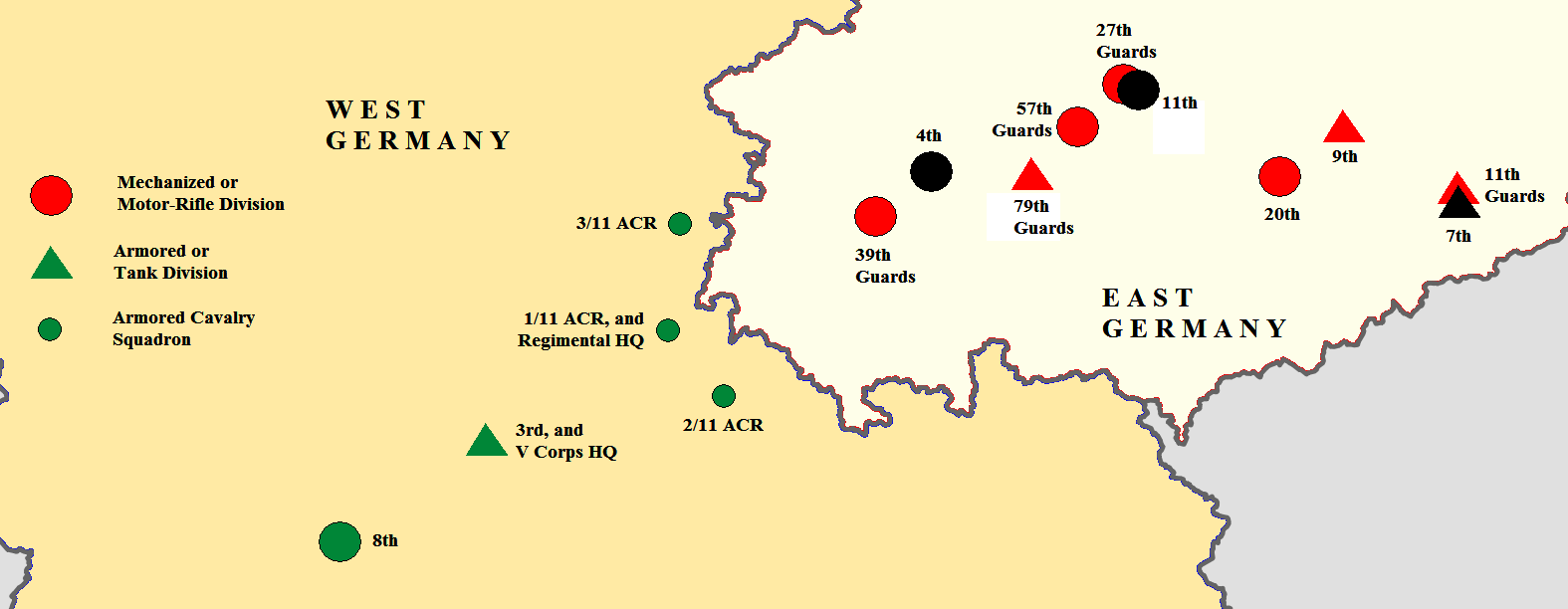
Deployment of U.S., Soviet, and East German formations in 1985 |
In a state of constant readiness, the two armored cavalry regiments of V Corps were among the most battle-ready formations of U.S. Army Europe. The armored cavalry troops and their supporting tank and artillery units were always in one of three states – they were on border surveillance duty, or on gunnery exercises at training ranges, or recovering unit readiness at their home barracks and ready to deploy on demand as required by alerts. Regimental headquarters continuously ran a border operations center that remained in communication with observation and listening posts manned by cavalry scouts along the inner German border, and passed along reports of Soviet and East German activity to V Corps Headquarters in Frankfurt.
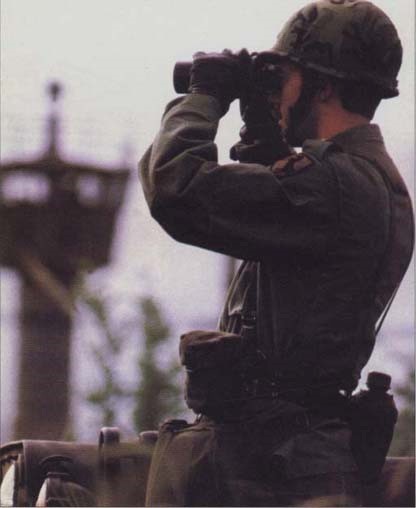
Soldier of the 11th Armored Cavalry on border operations (Photo: U.S. Army) |
|
Put your head between your legs, and kiss your ass goodbye
- GI humor, referring to the posture one should adopt in preparation for an imminent nuclear blast. |
As important as such qualities as the relative strength, training, and morale of the opposing conventional forces on either side of the Fulda Gap were, the tactical and operational situation was always overshadowed by what were initially atomic, and later, nuclear weapons. The awkward aerial bombs that ended the Second World War were rapidly developed during the 1950’s into smaller weapons suited to delivery and deployment by tactical formations of both sides.
Until August 1949, the U.S. possessed atomic weapons while the Soviets did not. It was a huge trump card that allowed the U.S. to draw down its strength in Europe – until a combination of Soviet espionage and research produced their own atomic bomb. The Korean War broke out the following year and remained a conventional conflict, despite neither North Korea nor China possessing atomic weapons. Against the expert wisdom of the time, the use of atomic weapons in wartime had not proved inevitable.
Nevertheless, the use of such weapons remained a temptation for both sides during the Cold War in Europe, especially as “tactical” nuclear weapons with limited destructive effects were developed. The Soviets developed offensive plans in which such weapons were to blast a path through NATO defenses with the object of rapidly occupying all of West Germany. The U.S. believed the concentration of forces required for a Soviet attack would present opportunities for the destruction of large enemy formations at a single blow. Less decisively, smaller weapons of mass destruction were seen as “super demolitions” to close off valleys with tree blow-downs on a large scale as well as the generation of irradiated rubble that would have been very time-consuming and logistically difficult to remove.
In the case of the Fulda Gap, both sides could find reasons for the employment of tactical nuclear weapons. With even a small amount of warning, V Corps could have heavily reinforced the cavalry units in the Fulda Gap and mounted a strong defense – perhaps prompting Soviet use of tactical nuclear weapons to quickly achieve a breakthrough. Likewise, the topography and forestation of the Fulda Gap invited the use of such weapons by the U.S. to block armored avenues of advance or strike large concentrations of Soviet troops and equipment. Understandably, the West Germans hoped fervently that in the event of war, neither side would succumb to the temptation to employ such destructive firepower.
Besides nuclear weapons, the other armaments bogeyman was the potential employment of chemical weapons. NATO believed the Soviets would employ chemical agents on a large scale in an attempt to slow down and disrupt NATO’s response to an attack. What is clear is the use of such weapons would have slowed down the operations of both sides. The individual protective gear of the Cold War was bulky, hard to move around in, and made communications, especially over radio or telephones, difficult and prone to misunderstanding. Further debilitating to unit effectiveness would have been the need to disinfect personnel, vehicles, and aircraft – not to mention the need to aid those stricken by chemical agents.
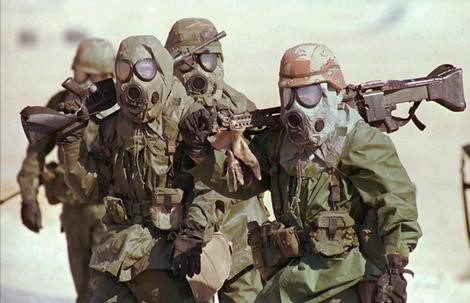
U.S. troops wearing the M17 gas mask |
But what seemed possible, perhaps even probable, during the unrelenting tension of the Cold War in Europe, appears horrific in hindsight. It is hard to imagine what the Soviets would have gained by occupying a West Germany littered with irradiated rubble and populated by terrified survivors overwhelmed by millions of dead. Even a single event like that of the 1986 Chernobyl meltdown left lasting effects in western Europe – to this day, wild boars shot by hunters in the mountains of Germany bordering the Czech Republic have to be tested for radioactive contamination because of their habit of pushing their snouts through soil still tainted by fallout that arrived almost thirty years ago.
Clearly, had weapons of mass destruction been used by either side during a struggle for the Fulda Gap, such an act would have represented an escalation massive enough to transform the entire war and perhaps even to render the possession of particular terrain features irrelevant. Military thought, at least on the side of the U.S., tended more to expectations of tactical armored combat in the Fulda Gap rather than the mass destruction of troop formations of either side. Of course, wars have never developed in the manner expected – and the peaceful valleys of the Rhön, the Spessart, and the Knüllgebirge could have ended up smoldering pits of incredible destruction so poisoned with radioactivity as to be beyond any foreseeable further human use.
|
They also serve who only stand and wait
- Milton, Sonnet XVII, On His Blindness |
The sudden collapse of communism in Eastern Europe led to an only slightly less rapid withdrawal of the Soviet Army back into the USSR, itself an entity that was not long for history after the events of 1989. With the Soviet withdrawal and the collapse of the East German state, the long-expected role of the Fulda Gap to be the “first battle of the next war” evaporated overnight. It was another year before the affairs of East Germany as a state were legally resolved, but in a stroke, the reason for having V Corps stationed in what became central Germany disappeared. Once the region ceased to be a military frontier, the Fulda Gap, long a powerful symbol of the Cold War, became an unremarkable group of valleys near the geographic center of Germany.
The war expected to start there never occurred, a victory for those who championed resolute behavior by democratic states as a way of warding off war. The U.S. Army, though, devoted little reflection to the contribution it made to the peace in Europe in the aftermath of the Second World War. Within a year of the communist collapse, Iraq invaded Kuwait and triggered a complex series of events and conflicts that are still ongoing. Although one can understand how subsequent events have consumed the Army’s attention, there is something improper about the relative lack of official acknowledgement of the sacrifices of generations of Americans who served over the 44 years of the Cold War.
“Cold” this period of ideological conflict may have dominantly been, but it was not bloodless. There were instances of deliberate killing by the Soviets such as the 1964 shoot-down of a lost jet trainer and its crew of three as well as such outrages as the murder of Major Arthur Nicholson in 1985. But even beyond deliberate action by the enemy, there were many accidental deaths of soldiers killed during realistic training in every kind of weather and at all hours of the day. Trucks plunged off icy bridges, explosives prematurely detonated, and aircraft fell out of the sky. The casualties were real if not nearly so intense as those suffered by units in combat, and these losses were incurred as a result of national policy. In U.S. Army Europe alone, the losses must have numbered into the thousands considering the length of time and number of tactical units involved. One source estimates over 400,000 deaths for all U.S. military services during the Cold War – a staggering total for a purported period of peace. For the families who lost soldiers, questions of war and peace mattered not – dead was dead – and the crushing suffocation of grief was, as ever, intense.
The primary beneficiary of this sacrifice has been Germany. After 45 years of partition, the Germans peacefully reunited and now enjoy a dominant political and economic position in the European Union.
If the service of American soldiers in the Fulda Gap has not exactly been celebrated by either the German or American federal governments, it has also not been altogether forgotten in the twenty years since U.S. forces there stood down and returned to the United States. Marker stones at the barracks in Bad Hersfeld, Fulda, and Bad Kissingen have been erected to the memory of the 14th and 11th Armored Cavalry Regiments. The former Downs Barracks in Fulda has become an industrial park with one foot planted firmly in the past, with modern buildings situated on roads named Black-Horse-Strasse and an adjacent athletic association fielding a baseball team called the “Fulda Blackhorses”.
The most substantial tribute to the defense of the Fulda Gap is to be found near the village of Rasdorf, once expected to be on the main route of Soviet invasion into central West Germany. There, Observation Point Alpha, a border surveillance camp once operated by the cavalry, has been converted into a museum. The museum depicts the lives of the soldiers who manned OP Alpha and allows visitors to understand the role of the camp in the greater context of the Cold War.
The former camp also offers a relaxing view of the verdant fields and forested hills leading into Thuringia – free of fencing, watch towers, troops, mines, and dogs whose sole purpose was to control the movement of peoples. For those who served in the Fulda Gap, perhaps the best reward is to be found in that view.
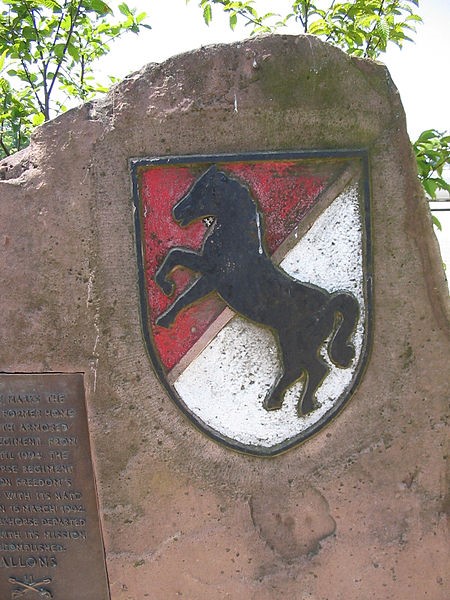
Memorial stone to the 11th Armored Cavalry on the former Downs Barracks in Fulda |
APPENDIX – ARMORED COMBAT IN THE FULDA GAP
The “first battle of the next war” was expected to be a massive clash of armor in the area of Rasdorf and Eiterfeld. Technically-minded readers may wish to know more about the tanks’ protection (armor) and the projectiles they fired to destroy other tanks.
At the end of the Second World War, tank cannon mainly fired two types of armor piercing projectiles. The first was full-caliber armor piercing (AP), usually capped (APC), and with a ballistic cap (APCBC). The limitations of practical size and weight for full-caliber armor piercing projectiles had been reached by 1945, and so a second type of projectile, called armor piercing discarding sabot (APDS), became the primary type employed in the Cold War. These projectiles employed sub-caliber penetrators that weighed less and could be fired at very high muzzle velocities. By the late 1960’s, the sub-caliber penetrators were of narrower diameter and fin-stabilized. These were known as armor piercing fin stabilized discarding sabot (APFSDS).
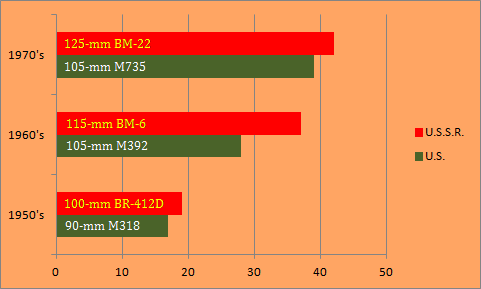
Selected kinetic projectiles of the Cold War Estimated penetration in centimeters of rolled homogenous armor at point-blank range |
During the 1950’s, a third type of armor piercing round came into widespread use, called high explosive anti tank (HEAT). HEAT projectiles used shaped-charge warheads to defeat armor. Although typically capable of penetrating more armor than kinetic projectiles of the era, HEAT rounds suffered from much shorter effective range. HEAT, though, had the advantage of keeping the same armor piercing performance at any range while kinetic rounds lost their armor penetrating capability over range as the projectile slowed down. HEAT rounds were also widely fielded with infantry units as the primary ammunition of antitank rocket launchers and recoilless rifles.
To defend against projectiles, tanks were protected by massive slabs of rolled homogenous armor, the thickest parts of which protected the front of the vehicle. By the end of the Cold War, the increasing effectiveness of HEAT rounds led to the development of advanced types of composite armor, such as the British-developed Chobham armor employed on M1 tanks. The Cold War saw a constant technical competition between tank armor and armor piercing projectiles, of which the development of Chobham armor was only one aspect. Training in the U.S. Army in the 1980’s emphasized “what can be seen can be hit and what can be hit can be killed”. With the development of sophisticated rangefinders, gun stabilization equipment, thermal sights, and various sensors, the effective range at which other tanks could be hit and destroyed increased several times from that typical in 1945.
| U.S. | U.S.S.R. | |
| 1950’s | 18cm (M48A1) | 20cm (T-55) |
| 1960’s | 18cm (M60) | 24cm (T-62) |
| 1970’s | 25cm (M60A3) | 38cm (early T-72) |
|
Maximum frontal armor of selected tanks of the Cold War
|
||
Although the armor piercing capability given in the chart above declined the farther the projectile traveled from the cannon’s muzzle, there is still a striking discrepancy in the penetration of the projectiles when compared to the amount of armor that a tank could carry and remain a mobile fighting machine. It was this discrepancy from which the Army’s guidance that “. . . what can be hit can be killed” was derived. To be hit was to be killed – a simple if lethal truism.
Beyond tank versus tank combat, the Fulda Gap battlefield would have bristled with guided missiles and antitank rocket launchers. No matter who would have won the battle, it is clear that the battlefield would have been littered with the destroyed hulks of thousands of armored fighting vehicles including armored personnel carriers, infantry fighting vehicles, self-propelled guided missile launchers, armored reconnaissance vehicles, self-propelled artillery pieces, and of course, tanks. Such carnage is difficult to imagine, but the 1973 battle in the Valley of Tears gives some idea on a smaller scale of how a battle for the Fulda Gap may have developed.
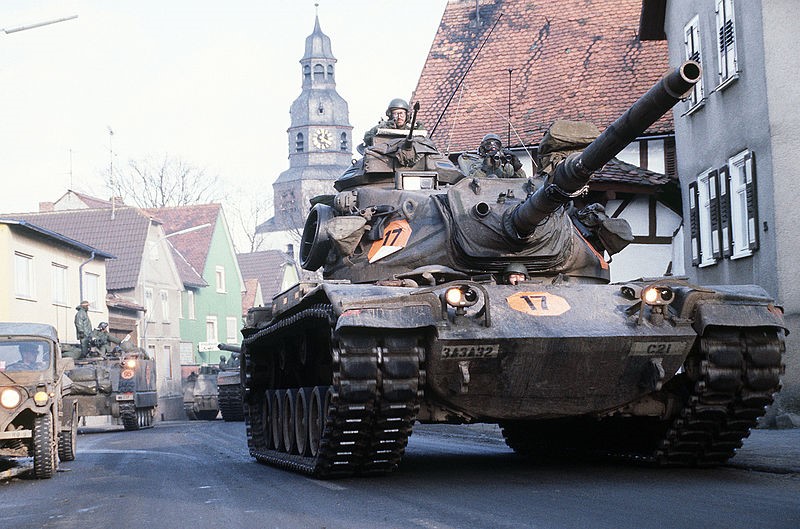
M60A3 of the 3rd Armored Division, 1985 (Photo: U.S. Army) |
| * * * |
Further Reading
Hugh Faringdon. Confrontation. The Strategic Geography of NATO and the Warsaw Pact. London and New York: Routledge and Kegan Paul, 1986.
V.I. Feskov et al., The Soviet Army in the period of the Cold War. Tomsk: Tomsk University Publishing House, 2004.
Christopher F. Foss. Jane’s Main Battle Tanks. London: Jane’s Publishing Company, 1986.
William E. Stacy. US Army Border Operations in Germany. Heidelberg: U.S. Army Europe, 1984. Available online at http://www.history.army.mil/documents/BorderOps/content.htm
Website “U.S. Army in Germany”. http://www.usarmygermany.com/
| * * * |
© 2025 Bill Wilson.
Written by Bill Wilson.
About the author:
Bill Wilson is a military history enthusiast whose interest is the organization of the military forces of the Second World War. He served in the U.S. Army in Germany during the Cold War and currently resides in Europe.
* Views expressed by contributors are their own and do not necessarily represent those of MilitaryHistoryOnline.com.







